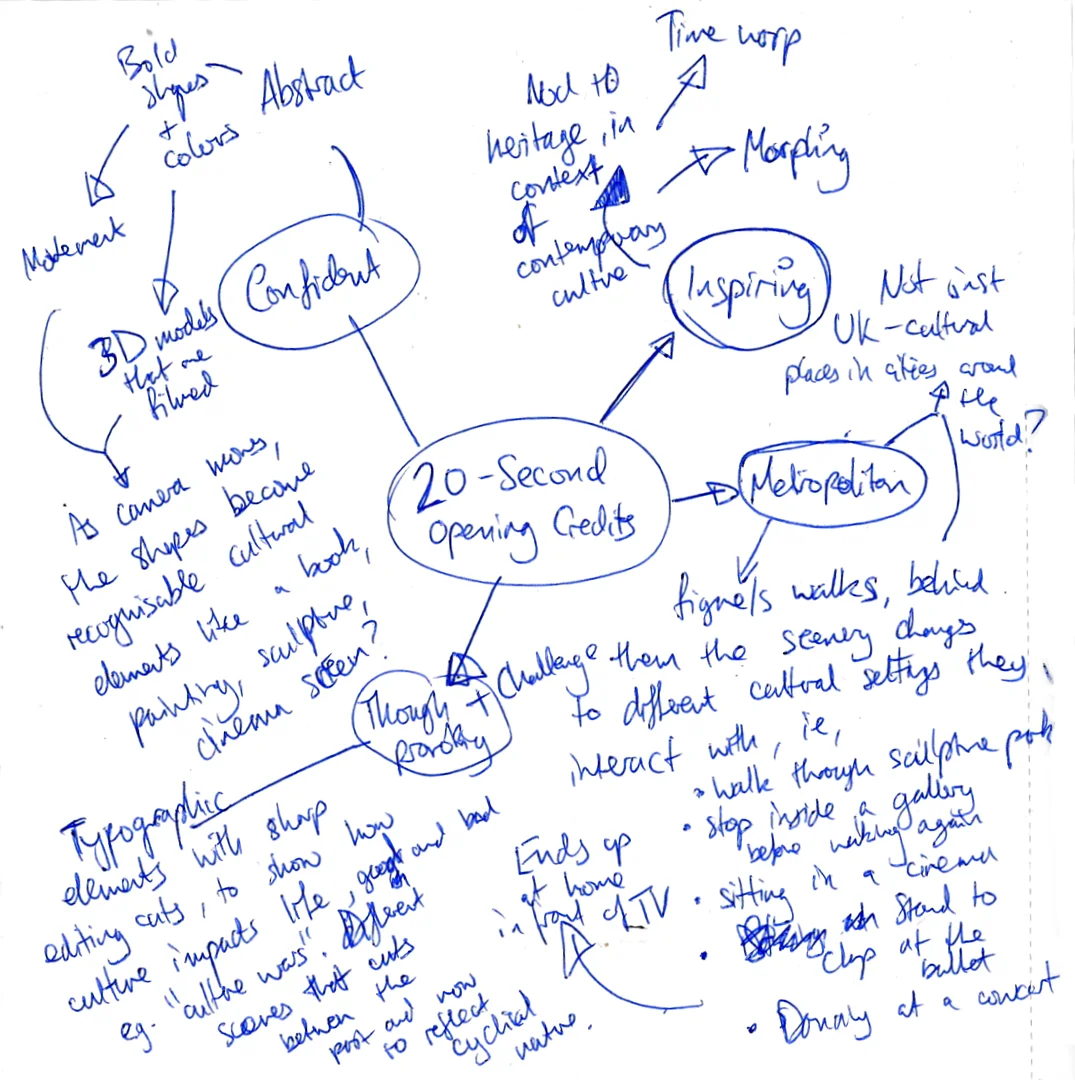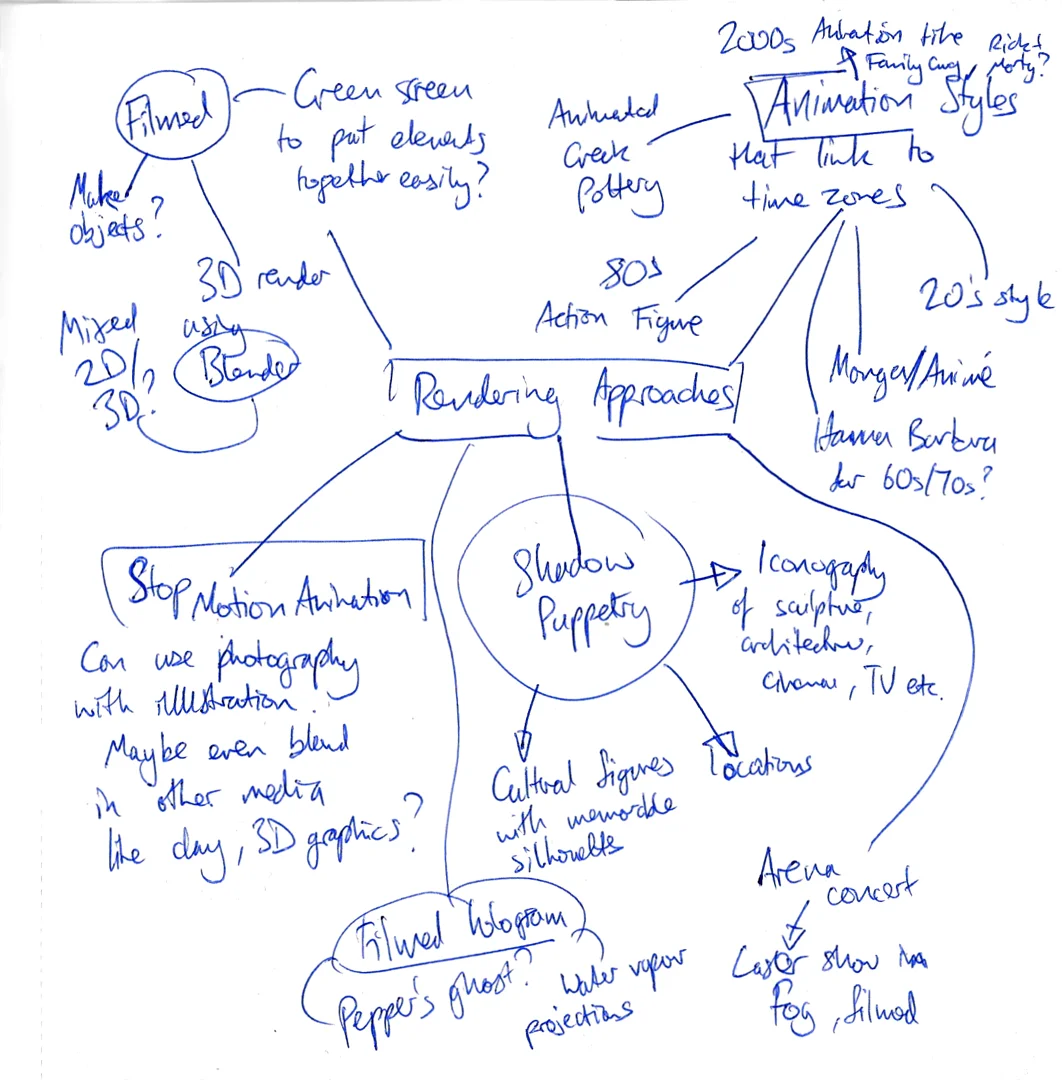For this exercise, I was asked to go back to the three briefs in the first research task. I was then tasked to think about how I would respond to one of the briefs to create a rationale on how to meet the brief. Given I scored each of the briefs, I decided to pick the BBC 2 brief as it scored highest, and still allowed a lot of creative freedom. The exercise was still a little unclear to me in terms of the learning objectives.
rationale /ˌraʃəˈnɑːl/ noun - a set of reasons or a logical basis for a course of action or belief
From this, I inferred the ask is to come up with a sequence of tasks and/or events on how I could address the brief's needs. However, the instructions also mentioned the need to "think creatively about how you respond" and "you might find you have more than one rationale" which suggested to me I also had to include not just the steps but to think about how I might creatively approach the specific challenge of the brief.
Workflow

I thought through the general approach for creative projects, and laid it out into a sequence to help organise my thoughts and planning. Looking at the brief as-is, I was conscious that I would need to ask the client some follow-up questions and/or research and source information. Given the artificial nature of this exercise, I had to pretend that I had done these steps to have the best understanding of the brief possible.
Next, I would look to get to the 'essence' of the brief and the emotional impact they want the opening credits to have. For this, I would look through the brief and pick out important keywords and/or information:
Core Concepts: Surprise, inspire, challenge, innovative, cutting-edge, thought-provoking
Show Identity: Forward-looking, stylish, confident, witty
Target Audience: Young (25-44), discerning, metropolitan, culture lovers
Content Areas: Fashion, art, architecture, music, film, TV
Technical Considerations: 20-second sequence, BBC Producers' guidelines
The next step for me to explore potential approaches would be to explore these core elements using visual approaches like mind mapping. So I moved to my sketchbook to explore the concepts as expansively and divergently as possible at this stage.
Visual catalogue
After I had explored things in my sketchbook, I did some research on documentary and magazine shows to get an idea of how different creatives have tackled their opening credits.
I also researched the actual culture show titles to get a sense of its aesthetic:
A lot of the titles above are really impressive, but I was conscious that trying to accomplish similar results myself may well be out of my skill set. Looking at my sketchbook explorations, I am pleased to see that the options I explored give me different ways to interact and combine with each other. This would give me more opportunities to come up with a concept that I would be able to complete for the competition.
Combinations
Were I to take the brief through the next steps of the process, I would transfer the most promising options from my exploration onto cards or post-its so that I could move them around to create different combinations until I found one which I found exciting and achievable.
Looking at the options in this artificial situation, my instincts suggest that an approach using some kind of stop motion could be fun and have lots of opportunities to bring in different styles and elements. In my mind, I am reminded of the music video to Peter Gabriel's "Sledgehammer":
I don't think I would do it in the same way, but I would be able to explore lots of facets through photographs (a bit of Terry Gilliam?), illustrations and artwork. Perhaps utilising papercut skills. Given the tone of the magazine show, I think some elements of punk aesthetic could be interesting too. I am inspired by the character design they had for Hobie 'Spider-Punk' Brown in Spider-Man: Across the Spider-verse (2023):
After identifying the right combination, I would then explore how to focus on the key success factors within that context, thinking about style, typography, colour and music.
From this point, I would be set to produce thumbnails, which I would do using storyboard keyframes. This would then take me through the rest of the creative process:
Creating a rough working animatic similar to what I did in Illustration Sketchbooks:
Eliciting feedback if possible, tweak and iterate the approach.
Completing the final animation
Reflections
I don't think I have done an explicit rationale like this when considering how to tackle a brief. I didn't enjoy this approach, but I acknowledge that trying to tackle a brief blind would make me feel overwhelmed and anxious; the challenge would feel too big.
I am not sure explaining myself in this way would be very useful for my personal process. I also get overwhelmed if I feel that I have to know all the details upfront. I do think that breaking down tasks is essential for me, but I think creating sub-tasks for the major beats of my process is enough for me to identify if there are unusual elements that I need to account for, as well as giving me space during the process of 'thinking out loud' for my brain to make connections and see opportunities which allow me to approach a brief more laterally.
References
Babungus (2018) Cosmos - A Spacetime Odyssey Intro, YouTube. Available at: https://www.youtube.com/watch?v=MoegC90zVLk (Accessed: 08 November 2024).
blurredphoto1 (2008) YCN - BBC - The Culture Show, YouTube. Available at: https://www.youtube.com/watch?v=4huJVonFsck (Accessed: 08 November 2024).
captweasle (2017) ‘Abstract: The Art of Design’ Episode 03 Title Sequence, YouTube. Available at: https://www.youtube.com/watch?v=1L8a6SwFPqg (Accessed: 08 November 2024).
Gabriel, P. (2012) Peter Gabriel - Sledgehammer (HD version), YouTube. Available at: https://www.youtube.com/watch?v=OJWJE0x7T4Q (Accessed: 11 November 2024).
HowWeBuiltBritain (2008) How We Built Britain - Titles, YouTube. Available at: https://youtu.be/1F3HvijeQSo?si=jD2H0owTJw_dT_M6 (Accessed: 08 November 2024).
Q7 Productions (2019) South Bank Show Intros, YouTube. Available at: https://youtu.be/zYUtdRmfoSs?si=tux2iqtKdbyRoi0G (Accessed: 08 November 2024).



Comments